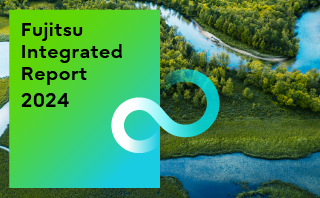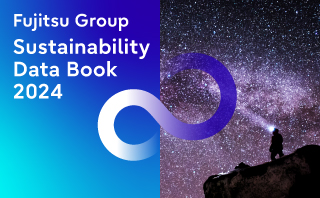-
Sustainability at Fujitsu Group
- Sustainability Management in the Fujitsu Group
- GRB(Global Responsible Business)Goals and Achievments for FY2022
- GRB(Global Responsible Business)Goals for FY2025
- Fujitsu's accessibility
- Stakeholder Engagement
- United Nations Global Compact
- SDG-related Activities in Fujitsu
- External Recognition and Awards
-
Global Responsible Business
- Environment
-
- Environmental Management
- The Fujitsu Group Environmental Vision on Climate Change
- Living in Harmony with Nature (Conservation of Biodiversity)
- Environmental Action Plan
- Environmental Data
- Environmental Communication
- Environmental Social Activities
- Disposal and Recycling of ICT products
- Environmental Considerations in ICT Products
- Governance
-
Data and Documents
- Fujitsu Group Sustainability Data Book 2024
- Social, Governance and Environmental data
- Independent Assurance Report

- GRI Standards / United Nations Global Compact (UNGC) principles Comparison Table
- SASB Standards Comparison Table
- Sustainability Information Disclosure Framework
- Link to regions responsible business reports
- Contact
- Sitemap
Green Procurement
- Procurement Activities Based on Green Procurement Direction
- Establishment of Environmental Management System
- CO2 Emission Reduction Initiatives
- Water Resource Conservation Initiatives
- Acquiring and Managing Information on Chemical Substances Contained in Products
- Establishing a Chemical Substance Management System (CMS) for Product Substances
We are implementing green procurement alongside our business partners, to provide customers with products and services that have light environmental footprints.
Procurement Activities Based on Green Procurement Direction
The Fujitsu Group summarized its requirements for business partners regarding the purchase of green parts, materials, and products, in the "Fujitsu Group Green Procurement Direction." This standard is posted on a multilingual basis (in three languages) in order to promote penetration to our business partners. We make an effort to communicate by various means, such as briefing sessions or individual meetings if necessary. Through such activities, the Group implements green procurement activities in conjunction with its partners in Japan and overseas and it promotes procurement from business partners that fulfill the green procurement requirements (see below).
Using the Fujitsu Group Environmental Survey Sheet, we conduct annual monitoring of our business partners' statuses with regard to environmental management systems, CO2 emission reduction, biodiversity preservation, and water resource preservation activities, and ask them to take appropriate measures. When making requests, we provide them with various kinds of information—such as guidance on activities to reduce CO2 emissions, explanatory documents related to water risk, and the water risk information tool AQUEDUCT—which have been useful for our business partners.
- Fujitsu Group Green Procurement Direction
https://www.fujitsu.com/global/about/procurement/green/
Green procurement requirements for business partners
| Requirements | Business partners
(materials/parts)(*1) | Business partners
(non-materials/parts) |
|---|---|---|
| 1.Establishment of environmental management systems (EMS) | ✔ | ✔ |
| 2.Compliance with regulations for Fujitsu Group specified chemical substances | ✔ | ― |
| 3.Establishment of chemical substance management systems (CMS) | ✔ | ― |
| 4.CO2 emission control/reduction initiatives | ✔ | ✔ |
| 5.Biodiversity preservation initiatives | ✔ | ✔ |
| 6.Water resource preservation initiatives | ✔ | ✔ |
- (*1)Business partners (materials/parts): Business partners that supply components for Fujitsu Group products or OEM/ODM products
Establishment of Environmental Management System
We request our business partners to establish environmental management systems (EMS)(*2) as a base for ensuring that they independently and continuously improve their environmental-preservation activities. In general, we prefer them to have third party-certified EMS. If this is difficult, we ask them to build an EMS that incorporates a PDCA cycle suited to their circumstances.
- (*2)EMS: Environmental management systems.
CO2 Emission Reduction Initiatives
The Fujitsu Group also asks our business partners to work toward CO2 emission reduction in hopes of addressing climate change.
Specifically, we ask them to clearly express the intentions of their initiatives and request that they make efforts to achieve the objectives they set. We also ask them to collaborate with external organizations, where possible, and encourage their own suppliers to make similar efforts, in order to expand the initiatives outside their respective businesses. Our annual Supply Chain Business Continuity Survey gives us a clear picture of how business partners are responding to a variety of climate-change risks, including tsunamis, floods, and torrential rains.
Moreover, we are asking our main suppliers to establish a CO2 reduction target based on the international standard of Science Based Targets (SBT) as we strive to further reduce global warming.
Water Resource Conservation Initiatives
As populations grow rapidly and water sources become progressively more contaminated, the increased need for water around the world, as well as water resource scarcity, has become an international challenge. Water resource conservation initiatives are necessary, even in business activities. The Fujitsu Group asks its business partners to investigate and understand the water risks associated with their own companies, and engage in water resource conservation initiatives, such as preventing water pollution and reducing water use.
Acquiring and Managing Information on Chemical Substances Contained in Products
Countries around the world are establishing legal regulations as to the chemical substances contained in products, for instance the RoHS directive(*3) and the REACH regulation(*4), with an increasing range of chemical substances, products and applications subject to these regulations.
The Fujitsu Group, using chemSHERPA(*5) as its standard format, investigates and acquires information on the chemical substances contained in our products. We also share this information within the Group, and have a system in place for quick adaptation when laws/regulations are revised or when new regulations are enacted.
- (*3)RoHS directive: Directive on the Restriction of the Use of Certain Hazardous Substances in Electrical and Electronic Equipment
- (*4)REACH regulation: Regulation for Registration, Evaluation, Authorization, and Restriction of Chemicals
- (*5)chemSHERPA: Chemical Information Sharing and Exchange under Reporting Partnership in Supply Chain
Establishing a Chemical Substance Management System (CMS) for Product Substances
In addition to obtaining information on chemical substances contained in our business partners’ products, the Fujitsu Group also asks these partners to establish a Chemical Substances Management System (CMS) based on the industry-standard JAMP(*6) guidelines for the management of such chemical substances. Doing so enables the Group to comply even more thoroughly with laws and regulations related to the chemical substances contained in our products.
The Group also carries out CMS audits in order to confirm appropriate establishment and operation of such CMS. More specifically, Fujitsu Group's auditors implement on-site evaluation of the management status of the chemical substances contained in our business partners’ products. If there are any inadequacies, auditors make requests for corrections and provide support for their enactment. Even after the establishment of CMS, we maintain awareness of its operation status through periodic audits.
- (*6)JAMP: Joint Article Management Promotion-Consortium.


